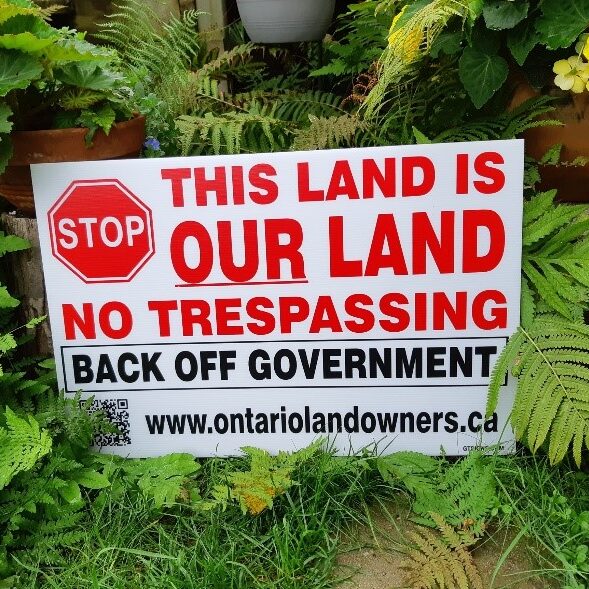News from North Renfrew United Landowners by Dawn Jeffries
- 2015-11-01
- By admin
- Posted in Latest News
Mark Breckon, vice president of the North Renfrew United Landowners (NRUL), rolled out the NRUL website at a general meeting of the NRUL members on Thursday, October 15 at the Deep River library. The website was developed in order to fulfill the NRUL’s mandate to educate its members, and the general public at large, about private property rights. NRUL is the third chapter of the Ontario Landowners Association (OLA) to have their own website.
Members of the audience were impressed with the search capabilities of the website. Searches of articles can be done on individual words or phrases, or by predefined categories. A suggestion to include a membership form has already been implemented. A blog will be added in the near future and other suggestions for improvements are welcome. Check out the website at www.nrul.ca
Janis Gulens, treasurer of the NRUL, then reviewed a draft constitution. The draft was an attempt to define in words who the NRUL is, what it wants to accomplish and how it will achieve those goals. It was purposely written with broad and general guidelines, trying not to be too restrictive. Members have until November 2 to make suggestions for changes to the draft constitution to any members of the executive. The executive will then prepare a final version of the constitution for presentation to the membership for ratification at the next meeting on November 19 at 7 p.m. in the Deep River library.
The third order of business was a discussion on the direction the NRUL should pursue in the future.
Four members of the NRUL attended the Ottawa Riverkeeper Annual Public meeting in Ottawa on October 6. Ottawa Riverkeeper is a member of the Waterkeeper Alliance founded by Robert F. Kennedy Jr.. Ottawa Riverkeeper is an independent, non-government, non-partisan organization dedicated to protecting the health of the Ottawa River and its tributaries.
Meredith Brown, Riverkeeper, summarized the highlights of the year. One of their ongoing initiatives is to obtain Heritage River status for the Ottawa River by 2017 for Canada’s 150th anniversary of confederation.
Guest speakers were Roch Bérubé, Executive Engineer, and Michael Sarich, Regulation Engineer, from the Ottawa River Regulation Secretariat. They gave a presentation on Dams, Water Levels and Climate Change on the Ottawa River watershed.
Bérubé explained that there were major floods on the Ottawa River in 1960, 1974, 1976, 1979, 1998, and 2002 due to excessive amounts of rainfall or melting snow. Most of the river is “uncontrolled” which means that a drop of rain will flow downstream because there is no storage capacity. Flooding occurs mainly in the uncontrolled areas of the river.
In 1983 an agreement between the Canadian, Ontario, and Quebec governments formed the Ottawa River Regulation Secretariat (ORRS) to manage water levels to provide protection against flooding. The ORRS is not a control board, and it does not have legal authority over operators of control facilities. The integrated management of the river by the ORRS shares the risk of flooding.
There is 13.9 billion m3 of storage capacity, mainly in the swamps in the northern part of the watershed. The average spring runoff is 31 billion m3, which leaves 17 billion m3 excess water to flow downstream. At the ORRS, data on rainfall, snow pack, snow melt, evaporation, infiltration, temperatures, and predicted weather from many stations are input into an Inflow Model. Computer programs model various scenarios to try and predict water levels in the river in the Outflow Model. Accurate predictions are difficult to obtain, because three-day weather forecasts are fairly reliable but 10-day forecasts are definitely not.
Decisions are made collaboratively to release water from dams. It takes almost 2 weeks for water to travel the length of the river. Once water is released at the source it must continue to the St. Lawrence through the 19 reservoirs along the way.
Unpredicted rainfall in Montreal 10 days later can cause flooding. Too much water in the south can be mitigated by holding water back in the north.
It is impossible to predict with precision the beginning of the freshet (snow melt), its magnitude or duration. A 20C day can speed up the process dramatically. Actual water levels and flood warnings at various stations along the river can be found at www.ottawariver.ca
The Ottawa River is a complex hydraulic system and there are ongoing challenges to manage the river levels to satisfy the conflicting objectives of different stakeholders from boaters to power generation.
The mandate of the ORRS is to hold back water for flood protection at the expense of hydro production. There are 43 generating stations on the Ottawa River with a capacity of 3500 MW, producing over $1 million worth of energy a day.
Bérubé explained that they do not see any trends regarding climate change. Over the last decade the earliest freshets have been recorded, yet in the last two years we have seen some of the latest freshets.
When asked a question regarding modeling of extreme exceptions that are becoming less exceptional, he replied that historically every river has a “big one” that hasn’t come yet. The fact that most of the big floods came before the ORRS was created is “just luck”. His advice was, “Don’t build on a flood plain”.
Search:
Categories
Archives
- April 2024
- January 2024
- December 2023
- November 2023
- August 2023
- July 2023
- June 2023
- May 2023
- April 2023
- March 2023
- February 2023
- January 2023
- December 2022
- November 2022
- October 2022
- September 2022
- August 2022
- July 2022
- June 2022
- May 2022
- April 2022
- March 2022
- February 2022
- January 2022
- December 2021
- November 2021
- October 2021
- September 2021
- August 2021
- July 2021
- June 2021
- May 2021
- April 2021
- March 2021
- February 2021
- January 2021
- December 2020
- November 2020
- October 2020
- September 2020
- August 2020
- July 2020
- June 2020
- May 2020
- April 2020
- March 2020
- February 2020
- January 2020
- December 2019
- November 2019
- October 2019
- September 2019
- August 2019
- July 2019
- June 2019
- May 2019
- April 2019
- March 2019
- February 2019
- January 2019
- December 2018
- November 2018
- October 2018
- September 2018
- August 2018
- July 2018
- June 2018
- May 2018
- April 2018
- March 2018
- February 2018
- January 2018
- December 2017
- November 2017
- October 2017
- September 2017
- August 2017
- July 2017
- June 2017
- May 2017
- April 2017
- March 2017
- February 2017
- January 2017
- December 2016
- November 2016
- October 2016
- September 2016
- August 2016
- July 2016
- June 2016
- May 2016
- April 2016
- March 2016
- February 2016
- January 2016
- December 2015
- November 2015
- October 2015
- September 2015
- August 2015
- July 2015
- June 2015
- May 2015
- April 2015
- March 2015
- February 2015
- January 2015
- December 2014
- November 2014
- October 2014
- September 2014
- August 2014
- July 2014
- June 2014
- May 2014
- April 2014
- March 2014
- February 2014
- January 2014
- December 2013
- November 2013
- October 2013
- September 2013
- August 2013
- June 2013
- April 2013
- October 2012
- May 2012
- September 2011



